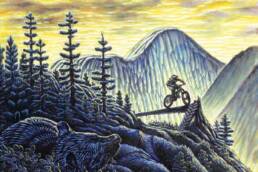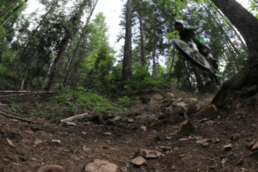[divider]
A collection of essays from Coast Mountain Culture’s writers that explores how science supports our bodies as we play in the outdoors.
Think you know how the bicycle’s magical equation of metal, rubber, gears and grease keeps us moving? Think again.
 For humans, stuck as we are in our terrestrial forms, the bicycle is quite possibly the closest thing we have to wings. On bikes we bomb down mountainsides, cruise through pastoral country roads or hammer away in a gym so the blood flows quick and thick and juicy red.
For humans, stuck as we are in our terrestrial forms, the bicycle is quite possibly the closest thing we have to wings. On bikes we bomb down mountainsides, cruise through pastoral country roads or hammer away in a gym so the blood flows quick and thick and juicy red.
What’s overlooked is the true science of the bicycle. Not only is it still a relatively mysterious machine — scientists aren’t wholly sure about how certain attributes actually work, but keep reading — the bicycle is replete with unique capabilities that are undeniably astounding. It gives us what we need with very little output on our end.
Few of us know the extremity of the simple bicycle’s fascinating statistics. Consider a 140-pound cyclist travelling at a mellow 16 kilometres per hour burns 25 calories per 1.6 kilometres. If one egg is worth 80 calories of power, a cyclist can travel about five kilometres on one egg. A person walking would require three eggs to go the same distance. A loaded bus would need the equivalent of 24 eggs for each person it carries, a train 36 eggs per person, while your average car would need 93 eggs to carry one person five kilometres. When a human gets on a bicycle we become one of the most efficient animals on the planet. Let that sink in.
There’s a host of elements that go into this, but at its core is the inherent efficiency of the bike’s design. It squanders little energy, most of it in drag via aerodynamic resistance and contact friction, a test conducted by Johns Hopkins University engineers revealed that the bike’s chain drive alone posted an energy efficiency score of 98.6 per cent, meaning less than two per cent of the power used to turn the front sprocket was lost while being transmitted to the rear one. As a whole, the bicycle can be up to 98.1 per cent efficient in terms of converting energy at the pedals into forward motion. The common car is only about 30 per cent efficient.
That translates into some incredible accomplishments rarely celebrated by mainstream media. On land, Sebastiaan Bowier of the Netherlands holds the speed record, which clocked him in at 133.78 kilometres per hour in 2013. On October 30, 2014, German Jens Voigt set the world one-hour record when he logged 51.11 kilometres in 60 minutes at the Velodrome Suisse in Grenchen, Switzerland. I wonder how many eggs he ate.
Why so perfect a marriage of machine and body? Quite surprisingly, how the bicycle operates on a scientific level remains a mystery. While billions of dollars have been spent furthering performance and efficiency, very little has been put into understanding how the bicycle works.
For instance, a bicycle can stay upright without a rider as long as it’s moving at 13 kilometres per hour or faster. It’s what scientists call “self-stabilizing dynamics,” and it allows us to ride easily with no hands. One explanation for this phenomenon is when the moving bike begins to lean to one side, gravitational torque rotates the front wheel away from straight ahead and the bicycle starts to describe a circle. In reaction, the road surface applies a centripetal force that restores the wheel to pointing straight forward. The centripetal force also exerts a torque on the entire bicycle, which pushes it out of the leaning stance.[divider][% oiopub-banner-5-center %][divider]
But in a recent study by MIT students, who studied the bicycle’s physics extensively in an effort to create a self-stabilizing, autonomous bicycle, they were unable to quantify exactly how the bicycle is able to stay upright at a certain speed.
Like the bicycle itself — and more importantly, its struggle to rise as a most celebrated, glorified, and dare we say, legislated form of transportation — the question of how these two-wheeled marvels work appears so strikingly simple. In the end, perhaps we are better off ceasing to question its methods, while embracing its magic.

Mitchell Scott
Mitchell Scott is the longtime Editor-in-Chief and co-publisher of both Kootenay Mountain Culture and Coast Mountain Culture Magazines. He's been in the writing/publishing/media business for over 20 years and currently lives in Nelson, BC, where he tries to keep up with his two teenage sons with aching futility.
Related Stories
Nadine and the Machine – Meet One Of Sledding’s Best
Professional snowmobiling sensation Nadine Overwater has inspired so many female sledders, she can't keep up with…
KMC Editor’s Intro: Science is Art is Science
In his editor’s introduction of the March 2015 issue of Canada’s The Walrus magazine, John MacFarlane bids readers…
VIMFF
This is the introduction to the 2012 Vancouver International Mountain Film Festival. With films about mountain culture…
Frozen One
This comes from the creative geniuses housed up above the old post office in downtown Rossland, BC. Juicy Studios'…






